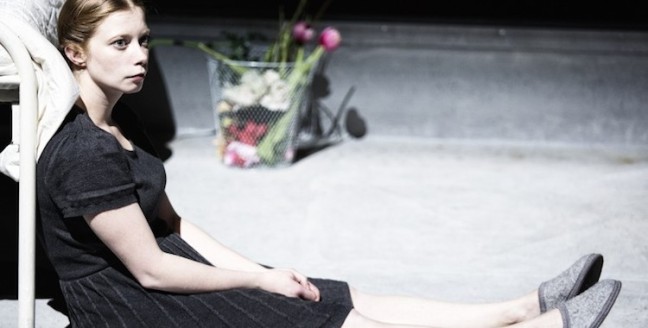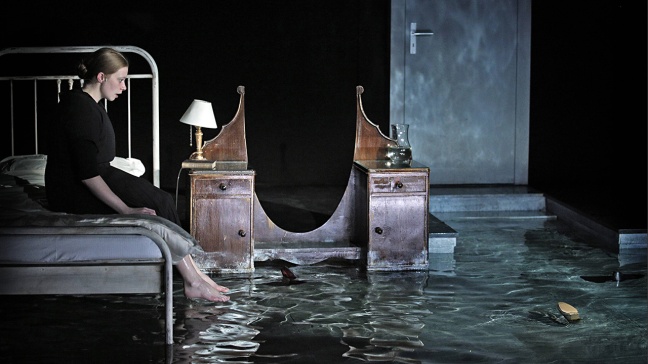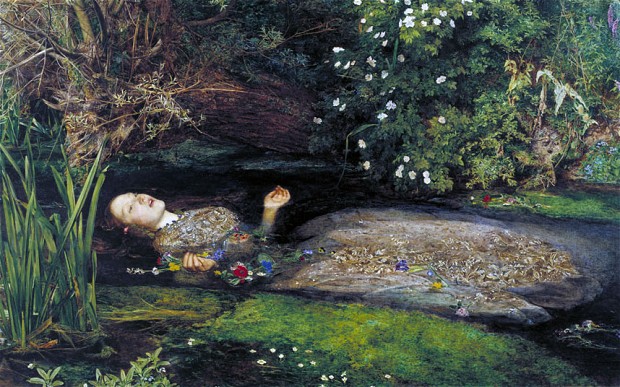In Katie Mitchell’s bleak re-centring of Hamlet, Ophelia is sinking from the start. Before we even see her, projected text and a voiceover tell us about the first of five stages of drowning. And when we do see her, she’s dragged under the waters of misogyny, submerged beneath layer upon layer of clothing. Thrash as she might, there’s no way back to the surface.
There’s a brutal inexorability to Ophelias Zimmer. For a start, we know where this is heading. Mitchell’s piece, created in close collaboration with writer Alice Birch and designer Chloe Lamford, trades heavily on its audience’s knowledge of Shakespeare’s play. From the moment the house lights go down, we’re anticipating Ophelia’s madness and watery death. More than that, though, inexorability is built into the very structure of Ophelias Zimmer. It plods, slowly, deliberately and relentlessly, towards its inevitable conclusion.
As the title suggests, the entire action (or inaction) of the piece is confined to Ophelia’s bedroom. The events of Hamlet, plotted out meticulously according to the play, all occur around this peripheral point. Most of the time, though, we watch the deadening routine of Ophelia’s life. She gets up, goes for a walk, reads and sews. Flowers arrive every day, every day tossed straight into the bin. Letters – or, as they are reimagined here, cassette tapes – arrive from Hamlet and are listened to, fast-forwarded and rewinded. An occasional cry of “Ophelia” summons her out of the room.
This is choreographed boredom. Tedium distilled. Each scene change, each jump forwards in time, is signalled with a ping as horrible and relentless as the bells that heralded torture in Mitchell’s production of Cleansed. Through it all, Jenny Konig’s Ophelia stares out with a chilling blankness, movements as controlled as the routine that dictates her quiet, contained life. She seems to be obeying the instructions of the intermittent voiceover we assume to be her dead mother, making herself as invisible and inaudible as possible in this rigidly patriarchal world.
Ophelia might be moved to the centre of the narrative, then, but Mitchell pointedly does not offer her a voice within it. As in Hamlet itself, she barely utters a sound. And when she does speak, her words are more habit than expression. “The flowers again,” she dully intones each morning as the maid brings in a new vase. While Hamlet might be robbed of his soliloquies (in a rare touch of humour, Ophelia cuts off his “to be or not to be” by promptly pressing the fast-forward button on her cassette player), Ophelia gets none of her own. Instead, she is confined to a disturbing silence that speaks deafeningly of the misogynistic world of Shakespeare’s play.
But can Ophelias Zimmer really be thought of as a feminist re-framing of Hamlet? It certainly reveals what Mitchell sees as the horrific treatment of Ophelia, including by Hamlet, exposing the careless misogyny of a character who is enshrined at the heart of the dramatic canon and with whom we are so often asked to sympathise. Yet still it restricts Ophelia to quiet, helpless misery, giving her no more agency than she has in Shakespeare’s telling. The whole narrative of the show, meanwhile, is structured around Hamlet and its controlling cast of men. Shakespeare’s play is the scaffolding holding up this piece, its male characters dominating from offstage with their comings and goings and shouted demands.
Hamlet himself is imagined by Mitchell and co as a brooding, moody narcissist, clad in black and wrapped up in his own worries. His messages to Ophelia, progressing from romantic cliché to sexually explicit plea to expletive-filled abuse, are all ultimately about him – his desire, his pain. On one of the few occasions when we actually see him, he bursts into Ophelia’s room brandishing a Joy Division record. He then goes on to play and dance to the soundtrack of his own suffering, wilfully ignorant of Ophelia’s.
Wildly thrashing his limbs to “Love Will Tear Us Apart”, Renato Schuch’s Hamlet invites an immediate comparison with Ian Curtis, a man tragically obsessed with death and determined to inhabit his own myth, even to the extent of his own destruction. But every act of destruction has its accidental victims, its civilian casualties, of which Ophelia is one. This is Hamlet as careless egotist, focused on his own meandering path to revenge at the expense of all others around him. While he dances, lost in indulging his own emotions, Ophelia sits in a chair and sobs.
This is one of a series of characteristically stunning theatrical moments that break up the monotony of Ophelia’s daily existence. Just as my attention threatens to drift away entirely, I find myself dragged back by a brilliant sound effect or by the slow, terrible seeping of water into the space. As ever with Mitchell’s work, there is an austere precision that can be disengaging, but as soon as one of those moments interjects I’m brought back on board, that knot in my stomach tightening again.
Immediately after the show, Tom Cornford tweeted that Ophelias Zimmer is “about the katiemitchellest thing you can imagine”. I know what he means: the horrible beauty, the compelling boredom, the pin-point precision, the intellectual rigour, the underlying queasiness, even the foley booth at one side of the stage producing the sounds that underscore Ophelia’s existence. While watching, I was reminded in particular of two other Mitchell pieces: her Schaubühne production of The Yellow Wallpaper – the claustrophobia, the mounting unease, the strange combination of boredom and nauseous tension – and the haunting video installation Five Truths.
The latter was Mitchell’s first take on Ophelia, whose madness was seen through the lenses of five twentieth century theatre practitioners: Constantin Stanislavski, Antonin Artaud, Bertolt Brecht, Jerzy Grotowski and Peter Brook. Here, Mitchell adds her own interpretation, and it is utterly uncompromising in its starkness and tedium. I struggle with it in the moment of watching, but I am also completely convinced that this oscillation between detachment and uneasiness is exactly what I’m supposed to be feeling. This is a life and death that Mitchell is determined not to prettify or over-dramatise.
As in Five Truths, the climax of Ophelias Zimmer offers an echo of John Everett Millais’s famous painting, but with a bloody twist. In Mitchell’s version, death is not beautiful or romantic or even straightforwardly tragic; it is brutal and ugly, a violent and sudden last resort. No wonder it’s usually kept offstage.




One thought on “Ophelias Zimmer, Royal Court”